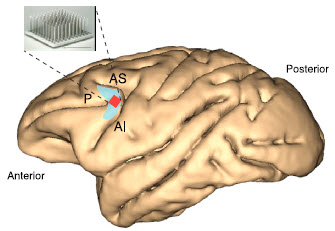Neuroscientists find neuron-network area that filters visual information and ignores distractions
January 8, 2015

Anatomical location of multielectrode-array implant (red square) in the macaque lateral prefrontal cortex area (8A), where simultaneously an active neuron network filters visual information and allocates attention (credit: Tremblay et al./Neuron)
McGill University researchers have identified a network of neurons in the lateral prefrontal cortex of the brain that interact with one another to enable us to quickly filter visual information while ignoring distractions.
The discovery could have far-reaching implications for people who suffer from diseases such as autism, ADHD, and schizophrenia and for brain-mind interface devices.
Our ability to pay attention to certain things while ignoring distractions determines how good we are at a given task, whether it is driving a car or doing brain surgery.
Predicting where a monkey will look next
The researchers recorded brain activity in macaque monkeys as they moved their eyes to look at objects being displayed on a computer screen while ignoring visual distractions. These recorded signals were then input into a decoder (running on a computer) that mimicked the kinds of computations performed by the brain as it focuses.
There were some startling results. “The decoder was able to predict very consistently and within a few milliseconds where the macaques were covertly focusing attention even before they looked in that direction,” says Julio Martinez-Trujillo, of McGill’s Department of Physiology and the lead author of the paper. “We were also able to predict whether the monkey would be distracted by some intrusive stimulus even before the onset of that distraction.”
Practical uses for therapy and brain-machine interfaces
But even more interesting, the researchers could manipulate the decoder’s ability to “focus” by subtly manipulating the neuronal activity that was just recorded to induce “focused” and “distracted” states.
“This suggests that we are tapping into the mechanisms responsible for the quality of the attentional focus, and might shed light into the reasons why this process fails in certain neurological diseases such as ADHD, autism, and schizophrenia,” says Sébastien Tremblay, a doctoral student at McGill University and the first author of the paper published in the current edition of Neuron.
The researchers also found that the neural ensembles in this area were more effective than single neurons for focusing attention and controlling gaze, suggesting that tapping into these signals might be helpful in neural prosthetics, such a brain-mind machines, to allow people who are paralyzed to use their thoughts to control objects in their environment more effectively.
Abstract for Attentional Filtering of Visual Information by Neuronal Ensembles in the Primate Lateral Prefrontal Cortex
The activity of neurons in the primate lateral prefrontal cortex (LPFC) is strongly modulated by visual attention. Such a modulation has mostly been documented by averaging the activity of independently recorded neurons over repeated experimental trials. However, in realistic settings, ensembles of simultaneously active LPFC neurons must generate attentional signals on a single-trial basis, despite the individual and correlated variability of neuronal responses. Whether, under these circumstances, the LPFC can reliably generate attentional signals is unclear. Here, we show that the simultaneous activity of neuronal ensembles in the primate LPFC can be reliably decoded to predict the allocation of attention on a single-trial basis. Decoding was sensitive to the noise correlation structure of the ensembles. Additionally, it was resilient to distractors, predictive of behavior, and stable over weeks. Thus, LPFC neuronal ensemble activity can reliably encode attention within behavioral timeframes, despite the noisy and correlated nature of neuronal activity.